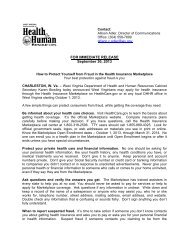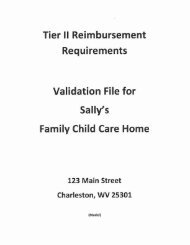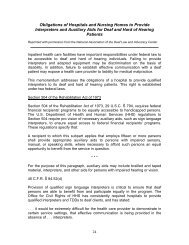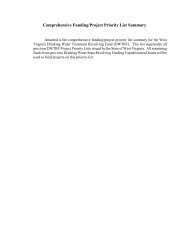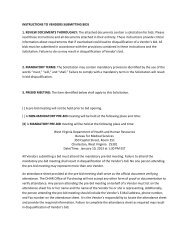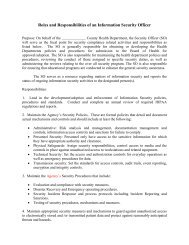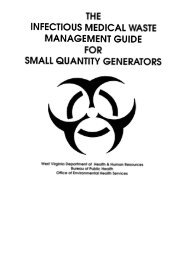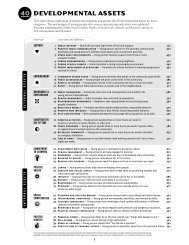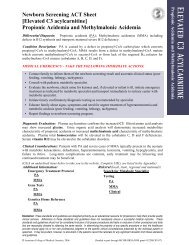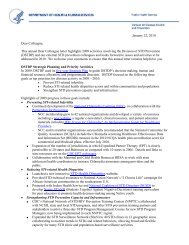Molina Medicaid Solutions - DHHR
Molina Medicaid Solutions - DHHR
Molina Medicaid Solutions - DHHR
You also want an ePaper? Increase the reach of your titles
YUMPU automatically turns print PDFs into web optimized ePapers that Google loves.
e10vkoccurrence, and an annual aggregate limit of $3 million, errors and omissions insurance in the amount of $10 million per occurrence and in aggregate for each policy year, andsuch other lines of coverage as we believe are reasonable in light of our experience to date. However, given the significant amount of some medical malpractice awards andsettlements, this insurance may not be sufficient or available at a reasonable cost to protect us from damage awards or other liabilities. Even if any claims brought against uswere unsuccessful or without merit, we would have to defend ourselves against such claims. The defense of any such actions may be time-consuming and costly, and maydistract our management’s attention. As a result, we may incur significant expenses and may be unable to effectively operate our business.Furthermore, claimants often sue managed care organizations for improper denials of or delays in care, and in some instances improper authorizations of care. Also,Congress and several state legislatures have considered legislation that would permit managed care organizations to be held liable for negligent treatment decisions or benefitscoverage determinations. If this or similar legislation were enacted, claims of this nature could result in substantial damage awards against us and our providers that couldexceed the limits of any applicable medical malpractice insurance coverage. Successful malpractice or tort claims asserted against us, our providers, or our employees couldadversely affect our financial condition and profitability.23Table of ContentsWe cannot predict the outcome of any lawsuit with certainty. While we currently have insurance coverage for some of the potential liabilities relating to litigation, othersuch liabilities may not be covered by insurance, the insurers could dispute coverage, or the amount of insurance could be insufficient to cover the damages awarded. Inaddition, insurance coverage for all or certain types of liability may become unavailable or prohibitively expensive in the future or the deductible on any such insurance coveragecould be set at a level which would result in us effectively self-insuring cases against us.Although we establish reserves for litigation as we believe appropriate, we cannot assure you that our recorded reserves will be adequate to cover such costs. Therefore,the litigation to which we are subject could have a material adverse effect on our business, financial condition, cash flows, or results of operations, and could prompt us tochange our operating procedures.We are subject to competition which negatively impacts our ability to increase penetration in the markets we serve.We operate in a highly competitive environment and in an industry that is currently subject to significant changes from business consolidations, new strategic alliances,and aggressive marketing practices by other managed care organizations. We compete for members principally on the basis of size, location, and quality of provider network,benefits supplied, quality of service, and reputation. A number of these competitive elements are partially dependent upon and can be positively affected by the financialresources available to a health plan. Many other organizations with which we compete, including large commercial plans, have substantially greater financial and otherresources than we do. For these reasons, we may be unable to grow our membership, or may lose members to other health plans.If state regulators do not approve payments of dividends and distributions by our subsidiaries, it may negatively affect our business strategy.We are a corporate parent holding company and hold most of our assets at, and conduct most of our operations through, direct and indirect subsidiaries. As a holdingcompany, our results of operations depend on the results of operations of our subsidiaries. Moreover, we are dependent on dividends or other intercompany transfers of fundsfrom our subsidiaries to meet our debt service and other obligations. The ability of our subsidiaries to pay dividends or make other payments or advances to us will depend ontheir operating results and will be subject to applicable laws and restrictions contained in agreements governing the debt of such subsidiaries. In addition, our health plansubsidiaries are subject to laws and regulations that limit the amount of dividends and distributions that they can pay to us without prior approval of, or notification to, stateregulators. In California, our health plan may dividend, without notice to or approval of the California Department of Managed Health Care, amounts by which its tangible netequity exceeds 130% of the tangible net equity requirement. Our other health plans must give thirty days advance notice and the opportunity to disapprove “extraordinary”dividends to the respective state departments of insurance for amounts over the lesser of (a) ten percent of surplus or net worth at the prior year end or (b) the net income for theprior year. The discretion of the state regulators, if any, in approving or disapproving a dividend is not clearly defined. Health plans that declare non-extraordinary dividendsmust usually provide notice to the regulators ten or fifteen days in advance of the intended distribution date of the non-extraordinary dividend. The aggregate amounts our healthplan subsidiaries could have paid us at December 31, 2008, 2007, and 2006 without approval of the regulatory authorities were approximately $7.6 million, $18.7 million, and$6.9 million, respectively. If the regulators were to deny or significantly restrict our subsidiaries’ requests to pay dividends to us, the funds available to our company as a wholewould be limited, which could harm our ability to implement our business strategy. For example, we could be hindered in our ability to make debt service payments under ourcredit facility and/or our senior convertible notes.Unforeseen changes in regulations or pharmaceutical market conditions may impact our revenues and adversely affect our results of operations.A significant category of our health care costs relate to pharmaceutical products and services. Evolving regulations and state and federal mandates regarding coveragemay impact the ability of our health plans to continue to receive existing price discounts on pharmaceutical products for our members. Other factors affecting our24Table of Contentspharmaceutical costs include, but are not limited to, the price of pharmaceuticals, geographic variation in utilization of new and existing pharmaceuticals, and changes indiscounts. The unpredictable nature of these factors may have an adverse effect on our business, financial condition, cash flows, or results of operations.Failure to maintain effective internal controls over financial reporting could have a material adverse effect on our business, operating results, and stock price.The Sarbanes-Oxley Act of 2002 requires, among other things, that we maintain effective internal control over financial reporting. In particular, we must perform systemand process evaluation and testing of our internal controls over financial reporting to allow management to report on, and our independent registered public accounting firm toattest to, our internal controls over financial reporting as required by Section 404 of the Sarbanes-Oxley Act of 2002. Our future testing, or the subsequent testing by ourindependent registered public accounting firm, may reveal deficiencies in our internal controls over financial reporting that are deemed to be material weaknesses. Ourcompliance with Section 404 will continue to require that we incur substantial accounting expense and expend significant management time and effort. Moreover, if we are notable to continue to comply with the requirements of Section 404 in a timely manner, or if we or our independent registered public accounting firm identifies deficiencies in ourinternal control over financial reporting that are deemed to be material weaknesses, the market price of our stock could decline and we could be subject to sanctions orinvestigations by the NYSE, SEC or other regulatory authorities, which would require additional financial and management resources.Volatility of our stock price could adversely affect stockholders.Since our initial public offering in July 2003, the sales price of our common stock has ranged from a low of $16.12 to a high of $53.23. A number of factors will continueto influence the market price of our common stock, including:• changes in expectations as to our future financial performance or changes in financial estimates, if any, of public market analysts,• announcements relating to our business or the business of our competitors,• state and federal budget decreases,• adverse publicity regarding health maintenance organizations and other managed care organizations,• government action regarding member eligibility,• changes in government payment levels,• changes in state mandatory programs,• conditions generally affecting the managed care industry or our provider networks,• the success of our operating or acquisition strategy,• the operating and stock price performance of other comparable companies in the health care industry,• the termination of our <strong>Medicaid</strong> or CHIP contracts with state or county agencies, or subcontracts with other <strong>Medicaid</strong> managed care organizations that contract withsuch state or county agencies,• regulatory or legislative change, and• general economic conditions, including unemployment rates, inflation, and interest rates.Our stock may not trade at the same levels as the stock of other health care companies or the market in general. Also, if the trading market for our stock does not continueto develop, securities analysts may not initiate or maintain research coverage of our company and our shares, and this could depress the market for our shares.25Table of ContentsMembers of the <strong>Molina</strong> family own a majority of our capital stock, decreasing the influence of other stockholders on stockholder decisions.Members of the <strong>Molina</strong> family, either directly or as trustees or beneficiaries of <strong>Molina</strong> family trusts, in the aggregate own or are entitled to receive upon certain eventsapproximately 56% of our capital stock. Our president and chief executive officer, as well as our chief financial officer, are members of the <strong>Molina</strong> family, and they are also onhttp://sec.gov/Archives/edgar/data/1179929/000095013409005437/a51362e10vk.htm[1/6/2012 11:14:47 AM]



